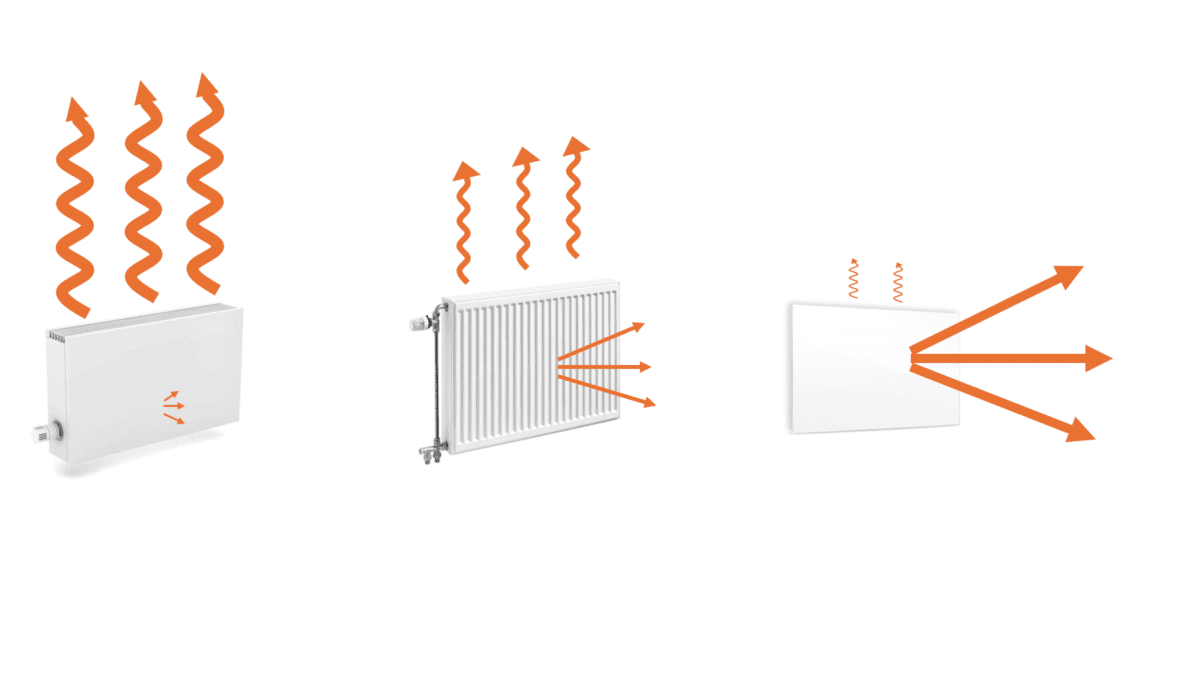Infrared underfloor heating is not infrared heating
Infrared underfloor heating is not infrared heating. "Infrared" underfloor heating essentially works no differently than electric underfloor heating, and therefore does not have the advantages of infrared panels. To explain why electric underfloor heating cannot be "infrared", we must explain when something is indeed infrared heating. What is infrared heating? In the transfer of heat, we know three mechanisms from physics:
- Conduction
- Convection (air)
- Radiation
Conduction as heat emission is not applicable in the built environment. When heating with convection, heat is transferred to the air, causing the air temperature in a space to rise. We know this from traditional underfloor heating, convertors, and radiators. With radiant heating, people and objects in the space are heated (which will also indirectly increase the air temperature). Heat-emitting bodies can transfer heat through both convection and radiation. This is illustrated below:

The size of the arrow shows the proportion of heat emission. From convector to radiator to radiant panel, the proportion of convection decreases and the proportion of radiation increases. In other words: the radiation efficiency increases. Here we introduce an important standard: IEC60675-3 – Household electric direct-acting room heaters – Methods for measuring performance – Part 3: Additional provisions for the measurement of the radiation efficiency The added value of this standard is multifaceted, but an important fact from this standard is that a direct (electric) emission system may only be considered infrared if the radiation efficiency is greater than or equal to 40%. In other words, at least 40% of the power consumed must be emitted as radiant heat. There are several variables that influence the radiation efficiency of a panel, including materialisation/construction and surface temperature. The art is to ensure that a surface temperature is achieved that leads to sufficient radiation intensity to heat an indoor space, and to insulate the panel in such a way that convection is prevented as much as possible. If these principles are applied to underfloor heating, then underfloor heating can only function as infrared heating if it achieves at least 40% of its heat emission via infrared radiation. This also requires a minimum surface temperature. Assuming that the prerequisites of insulation and construction are met, the minimum radiation efficiency of the floor will not be achieved because the surface temperature of the floor is far too low. For a floor to work as infrared heating, the surface temperature must be so high that it becomes very uncomfortable to walk on the floor (The advantage is that the children's game "the floor is lava" will require much less imagination). Electric underfloor heating is also often limited to about 35 degrees, insufficient for the floor to 'radiate' heat. In short, infrared underfloor heating is simply electric convection underfloor heating. Does this mean that electric underfloor heating is nonsensical? Not at all, there are applications one can think of. However, the terminology 'infrared' comes with certain expectations regarding its operation, and underfloor heating simply does not meet these expectations.



